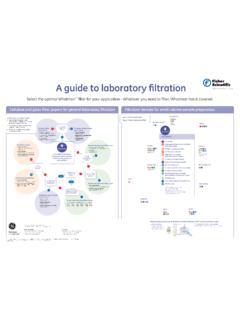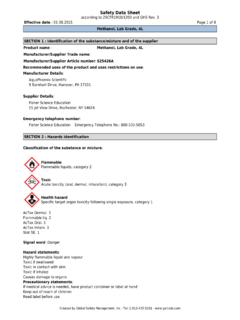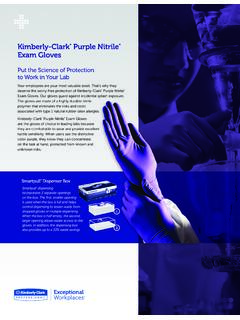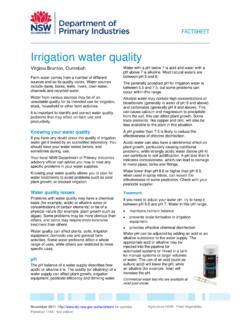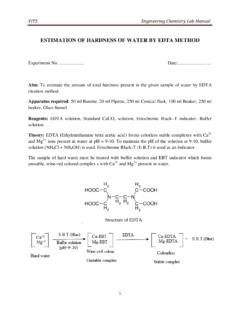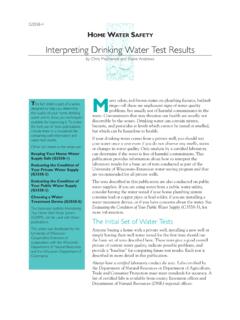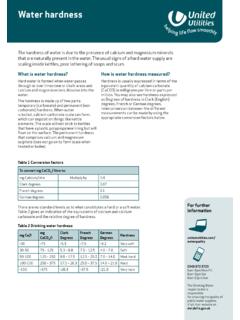Transcription of HARDNESS (2340)/EDTA Titrimetric Method 2-37 2340 …
1 2340 HARDNESS *2340 A. , water HARDNESS was understood to be a measure ofthe capacity of water to precipitate soap. Soap is precipitatedchiefly by the calcium and magnesium ions present. Other poly-valent cations also may precipitate soap, but they often are incomplex forms, frequently with organic constituents, and theirrole in water HARDNESS may be minimal and difficult to define. Inconformity with current practice, total HARDNESS is defined as thesum of the calcium and magnesium concentrations, both ex-pressed as calcium carbonate, in milligrams per HARDNESS numerically is greater than the sum of carbon-ate and bicarbonate alkalinity, that amount of HARDNESS equiva-lent to the total alkalinity is called carbonate HARDNESS ; theamount of HARDNESS in excess of this is called noncarbonatehardness.
2 When the HARDNESS numerically is equal to or lessthan the sum of carbonate and bicarbonate alkalinity, all hard -ness is carbonate HARDNESS and noncarbonate HARDNESS is HARDNESS may range from zero to hundreds of milligrams perliter, depending on the source and treatment to which the waterhas been of MethodTwo methods are presented. Method B, HARDNESS by calcula-tion, is applicable to all waters and yields the higher accuracy. Ifa mineral analysis is performed, HARDNESS by calculation can bereported. Method C, the EDTA titration Method , measures thecalcium and magnesium ions and may be applied with appro-priate modification to any kind of water .
3 The procedure de-scribed affords a means of rapid ResultsWhen reporting HARDNESS , state the Method used, for example, HARDNESS (calc.) or HARDNESS (EDTA). 2340 B. HARDNESS by preferred Method for determining HARDNESS is to computeit from the results of separate determinations of calcium , mg equivalent CaCO3/L [Ca, mg/L] [Mg, mg/L]2340 C. EDTA Titrimetric Discussiona. Principle:Ethylenediaminetetraacetic acid and its sodiumsalts (abbreviated EDTA) form a chelated soluble complex whenadded to a solution of certain metal cations. If a small amount ofa dye such as Eriochrome Black T or Calmagite is added to anaqueous solution containing calcium and magnesium ions at apH of , the solution becomes wine red.
4 If EDTA isadded as a titrant, the calcium and magnesium will be com-plexed, and when all of the magnesium and calcium has beencomplexed the solution turns from wine red to blue, marking theend point of the titration. Magnesium ion must be present toyield a satisfactory end point. To insure this, a small amount ofcomplexometrically neutral magnesium salt of EDTA is added tothe buffer; this automatically introduces sufficient magnesiumand obviates the need for a blank sharpness of the end point increases with increasing , the pH cannot be increased indefinitely because of thedanger of precipitating calcium carbonate, CaCO3, or magne-sium hydroxide, Mg(OH)2, and because the dye changes color athigh pH values.
5 The specified pH of is a satisfactorycompromise. A limit of 5 min is set for the duration of thetitration to minimize the tendency toward Interference:Some metal ions interfere by causing fading orindistinct end points or by stoichiometric consumption of this interference by adding certain inhibitors beforetitration. MgCDTA [see 2b3)], selectively complexes heavy met-als, releases magnesium into the sample, and may be used as asubstitute for toxic or malodorous inhibitors. It is useful onlywhen the magnesium substituted for heavy metals does notcontribute significantly to the total HARDNESS . With heavy metalor polyphosphate concentrations below those indicated in Table2340:I, use Inhibitor I or II.
6 When higher concentrations ofheavy metals are present, determine calcium and magnesium bya non-EDTA Method (see Sections 3500-Ca and 3500-Mg) andobtain HARDNESS by calculation. The values in Table 2340:I are*Approved by Standard Methods Committee, (2340)/EDTA Titrimetric Method2-37intended as a rough guide only and are based on using a 25-mLsample diluted to 50 or colloidal organic matter also may interfere withthe end point. Eliminate this interference by evaporating thesample to dryness on a steam bath and heating in a mufflefurnace at 550 C until the organic matter is completely the residue in 20 mL 1 Nhydrochloric acid (HCl),neutralize to pH 7 with 1 Nsodium hydroxide (NaOH), and makeup to 50 mL with distilled water ; cool to room temperature andcontinue according to the general Titration precautions:Conduct titrations at or near normalroom temperature.
7 The color change becomes impractically slowas the sample approaches freezing temperature. Indicator decom-position becomes a problem in hot specified pH may produce an environment conducive toCaCO3precipitation. Although the titrant slowly redissolvessuch precipitates, a drifting end point often yields low of the titration within 5 min minimizes the tendencyfor CaCO3to precipitate. The following three methods alsoreduce precipitation loss:1) Dilute sample with distilled water to reduce CaCO3con-centration. This simple expedient has been incorporated in theprocedure. If precipitation occurs at this dilution of 1 1 usemodification 2) or 3).
8 Using too small a sample contributes asystematic error due to the buret-reading ) If the approximate HARDNESS is known or is determined by apreliminary titration, add 90% or more of titrant to samplebeforeadjusting pH with ) Acidify sample and stir for 2 min to expel CO2beforepHadjustment. Determine alkalinity to indicate amount of acid to Buffer solution:1) Dissolve g ammonium chloride (NH4Cl) in 143 mLconc ammonium hydroxide (NH4OH). Add g magnesiumsalt of EDTA (available commercially) and dilute to 250 mLwith distilled ) If the magnesium salt of EDTA is unavailable, dissolve gdisodium salt of ethylenediaminetetraacetic acid dihydrate (analyticalreagent grade) and 780 mg magnesium sulfate (MgSO4 7H2O) or 644mg magnesium chloride (MgCl2 6H2O) in 50 mL distilled this solution to g NH4Cl and 143 mL conc NH4OH withmixing and dilute to 250 mL with distilled water .
9 To attain the highestaccuracy, adjust to exact equivalence through appropriate additionof a small amount of EDTA or MgSO4or Solution 1) or 2) in a plastic or borosilicate glasscontainer for no longer than 1 month. Stopper tightly to preventloss of ammonia (NH3) or pickup of carbon dioxide (CO2).Dispense buffer solution by means of a bulb-operated buffer when 1 or 2 mL added to the sample fails toproduce a pH of at the titration end ) Satisfactory alternate odorless buffers also are availablecommercially. They contain the magnesium salt of EDTA and havethe advantage of being relatively odorless and more stable than theNH4Cl-NH4OH buffer.
10 They usually do not provide as good an endpoint as NH4Cl-NH4OH because of slower reactions and they maybe unsuitable when this Method is automated. Prepare one of thesebuffers by mixing 55 mL conc HCl with 400 mL distilled water andthen, slowly and with stirring, adding 300 mL 2-aminoethanol (freeof aluminum and heavier metals). Add g magnesium salt ofEDTA and dilute to 1 L with distilled Complexing agents:For most waters no complexing agent isneeded. Occasionally water containing interfering ions requiresadding an appropriate complexing agent to give a clear, sharpchange in color at the end point. The following are satisfactory:1)Inhibitor I:Adjust acid samples to pH 6 or higher with bufferor Add 250 mg sodium cyanide (NaCN) in powderform.




